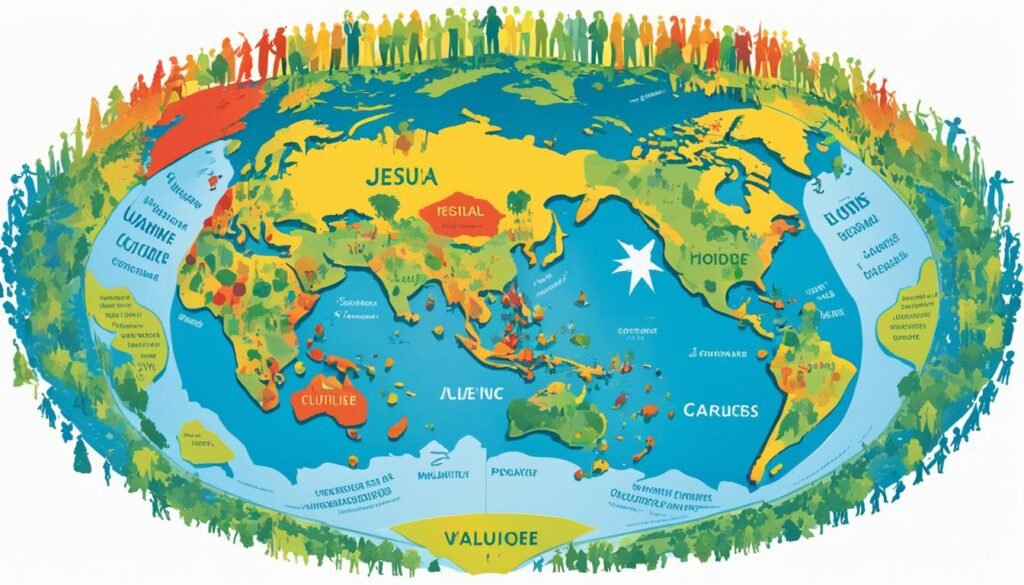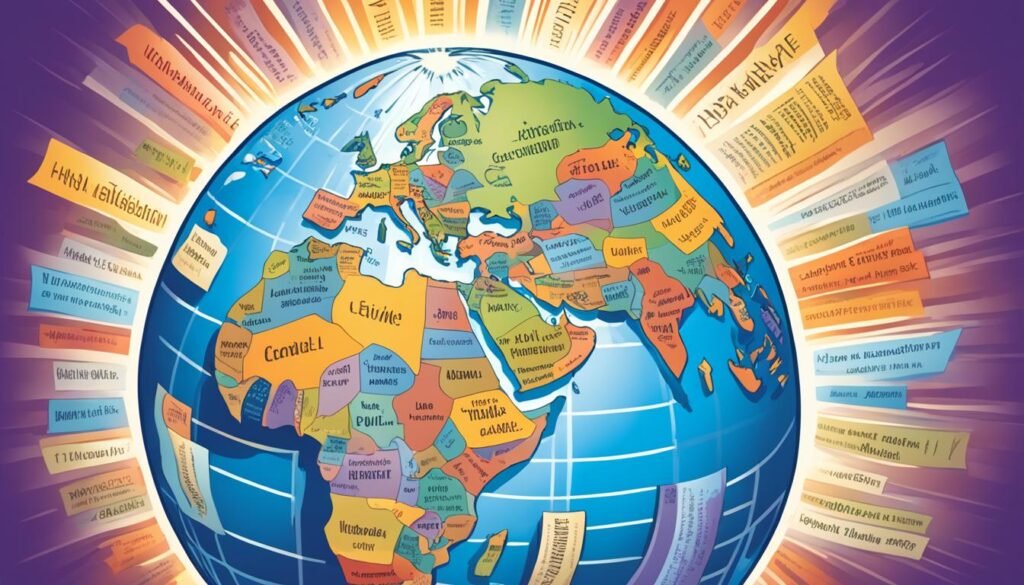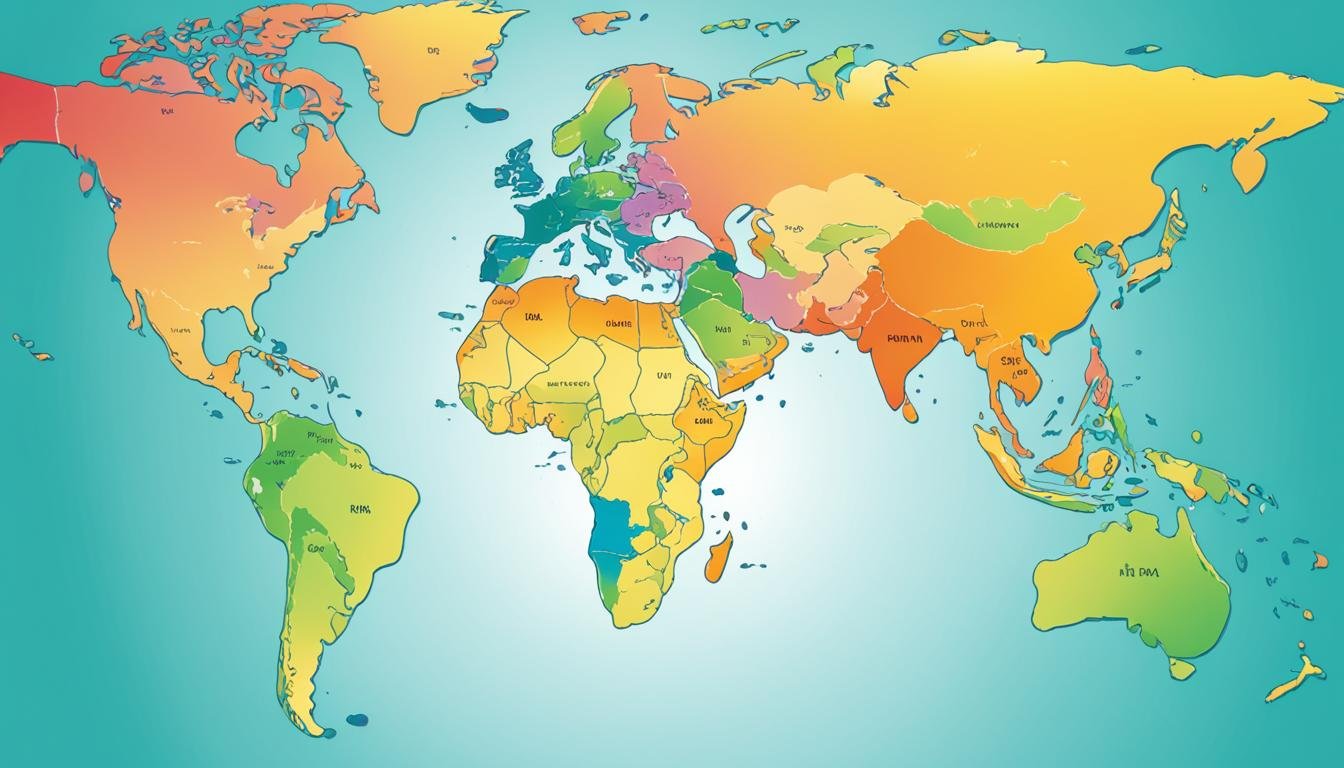Christianity has spread supernaturally, but there are still large segments of the population that have never heard of Jesus or received a clear presentation of the message of salvation. The spread of Christianity is not based on political boundaries but on reaching every ethnic people group. Approximately 40% of the world’s people groups, totaling over 7,400 groups, are considered unreached, meaning they have less than 2% Christ-followers and less than 5% Professing Christians. These unreached groups represent over 42% of the world’s population, with no indigenous community of believers able to evangelize their own people. This shows that a significant percentage of the world’s population has yet to hear about Jesus.
Key Takeaways:
- Approximately 40% of the world’s people groups, totaling over 7,400 groups, are considered unreached.
- These unreached groups represent over 42% of the world’s population.
- There is no indigenous community of believers able to evangelize their own people in these unreached groups.
Note: The image above illustrates the global distribution of people groups who have yet to hear about Jesus.
The Difference Between Countries and Ethnic People Groups
When Jesus commanded His followers to make disciples of all the nations, He was referring to ethnic people groups, not political countries. A people group is a significantly large grouping of individuals who share a common language, religion, ethnicity, residence, occupation, or other identifying factors. Many political countries contain multiple ethnic people groups, each with its own need for a church planting movement. This distinction highlights the need to specifically target and reach every ethnic people group, rather than just political boundaries.
Understanding the difference between countries and ethnic people groups is crucial in effectively spreading the message of Jesus Christ to all corners of the world. While political countries provide a convenient means of delineating territories, they do not capture the reality of the diverse cultural and linguistic landscapes within their borders. Focusing solely on countries could lead to overlooking specific needs and opportunities within diverse ethnic communities.
Our mission is not confined to political borders, but to reach every tribe, tongue, and nation with the transformative power of the Gospel. It requires a deliberate effort to engage and understand the unique cultural contexts and needs of each ethnic people group.”
For example, let’s consider the country of India, which is renowned for its cultural diversity. India is home to numerous ethnic people groups, each with its own distinct language, customs, and religious practices. By recognizing the existence of these diverse ethnic communities within a larger country, mission organizations can effectively strategize and mobilize resources to bring the message of Jesus to each people group in a meaningful way.
| Ethnic People Group | Population | Main Language |
|---|---|---|
| Hindi | 422 million | Hindi |
| Bengali | 83 million | Bengali |
| Marathi | 72 million | Marathi |
| Telugu | 71 million | Telugu |
Table: Ethnic People Groups in India
The table above illustrates the diversity of ethnic people groups within India. Each group has its own language, population size, and cultural distinctiveness. By recognizing and targeting these individual groups, mission organizations can tailor their outreach efforts, language translations, and discipleship materials to effectively engage with people in their heart language and cultural context.
Ultimately, understanding the difference between political countries and ethnic people groups enables mission organizations to strategically prioritize and allocate resources to reach every ethno-linguistic community with the transformative message of Jesus. It emphasizes the importance of recognizing and valuing the unique cultural identities within larger geopolitical boundaries and ensures that no ethnic people group is left without the opportunity to hear and respond to the Gospel.
Unreached People Groups
An unreached people group refers to a group of individuals who do not have an indigenous community of believing Christians capable of evangelizing their group. Currently, there are over 7,400 unreached people groups out of the approximately 17,400 ethnic people groups globally.
This alarming statistic reveals that more than 40% of the world’s people groups lack access to a local community of believers who can share the Gospel with them. The implications are significant, considering that within the largest 50 unreached people groups alone, there are over 1.4 billion individuals who have limited or no access to the Gospel.
These unreached people groups are primarily concentrated in the 10/40 Window, a region spanning from North Africa to Asia, encompassing parts of Africa, the Middle East, and Asia. The majority of these unreached people groups come from backgrounds predominantly following Islam, Hinduism, Buddhism, or practicing other ethnic religions.

“It is estimated that over 40% of the world’s people groups are considered unreached, meaning they lack access to a local community of believers who can share the Gospel with them.” – Unreached People Group Research
The table below provides additional insights into the top ten countries with the most unreached people groups:
| Country | Unreached People Groups | Population Affected (in millions) |
|---|---|---|
| India | 2,307 | 1,349 |
| China | 1,378 | 1,371 |
| Pakistan | 857 | 237 |
| Bangladesh | 798 | 160 |
| Nigeria | 536 | 66 |
| Indonesia | 424 | 281 |
| Egypt | 338 | 98 |
| Iran | 333 | 85 |
| Turkey | 331 | 81 |
| Algeria | 319 | 43 |
This data clearly demonstrates the extent of the challenges faced in reaching unreached people groups and the urgent need to prioritize efforts to share the Gospel with these populations.
Unengaged People Groups
Unengaged people groups are those that not only lack access to the Gospel but also have no known active on-site church planting effort or believers. Estimates suggest that there are possibly over 3,000 unengaged people groups worldwide. This means that these groups have no missionaries, outreach, church, Christian materials, or Bibles available to them. It is a great injustice that, 2,000 years after the Great Commission, there are still people groups without any witness in their midst. This highlights the need to specifically target and support efforts to reach these unengaged people groups.
| Challenges Faced by Unengaged People Groups | Impact of Unengaged People Groups |
|---|---|
| Data unavailable | Data unavailable |
| Data unavailable | Data unavailable |
| Data unavailable | Data unavailable |
| Data unavailable | Data unavailable |
Bible Translation Need
To effectively make disciples of Jesus, it is crucial to have the Scriptures available in the mother tongue of the people. However, there is still a significant need for Bible translation in many languages around the world. Currently, approximately 1,800 languages lack any Scripture translated, leaving millions of individuals without access to the Word of God in their own language.
This lack of Bible translation poses a major barrier when it comes to reaching unreached people groups. Many of these groups have limited literacy rates or primarily rely on oral communication, making written Scriptures inaccessible to them. Without the Bible in their mother tongue, these groups face difficulties in understanding and engaging with the message of the Gospel.
“The Bible says, ‘Faith comes by hearing, and hearing by the word of God.'” – Romans 10:17
Hence, providing the Scriptures in the language they understand best is crucial in effectively sharing the message of Jesus Christ with unreached people groups. It allows them to engage with the Gospel on a deeper level and facilitates discipleship within their own cultural context.

The Impact of Bible Translation
When the Bible is translated into the mother tongue of a community, it has a transformative effect. It enables individuals to hear the Gospel in a language that resonates deeply with their hearts and minds, breaking down the barriers of language and culture.
The presence of translated Scriptures has the following significant impacts:
- Empowers individuals to understand and respond to God’s Word in their own language.
- Fosters stronger engagement with the Gospel among oral learners and those with limited literacy.
- Preserves and promotes the local culture and language, honoring the uniqueness of each community.
- Facilitates discipleship and the growth of local churches by providing the foundation of biblical teachings.
- Enables believers to teach, worship, and share the Gospel in their mother tongue, strengthening the local church.
Through Bible translation, the Word of God becomes accessible and relevant to every language community, unlocking the potential for spiritual transformation and the spreading of the Good News.
The Need for Collaborative Efforts
Meeting the need for Bible translation requires collaborative efforts between churches, organizations, and translators worldwide. It involves linguists, theologians, and community leaders working together to accurately capture God’s message in different languages and dialects.
Additionally, sustainable financial support is crucial to ensure the completion and continued availability of translated Scriptures. Funding enables translators to dedicate their time and expertise to bring the Word of God to those who have yet to receive it in their mother tongue.
| Challenges | Opportunities |
|---|---|
|
|
Crafting carefully translated Scriptures requires time, dedication, and resources. However, the long-term impact of Bible translation on unreached people groups is immeasurable. It breaks down language barriers, enables deeper understanding, and strengthens local communities of faith.
“For the word of God is alive and active.” – Hebrews 4:12
In conclusion, Bible translation is a vital step in reaching unreached people groups with the message of Jesus Christ. It allows individuals to encounter the living Word of God in their own language, empowering them to understand, respond, and grow as disciples of Jesus. Collaborative efforts and financial support are essential in ensuring that every language community has access to the Scriptures in their mother tongue. By prioritizing Bible translation, we can bridge the language gap and bring the transformative power of the Gospel to the least reached.
Limited Access to the Gospel
Reaching unreached people groups poses a significant challenge due to limited access to the Gospel. The barriers include illiteracy and reliance on oral learning, as well as limited internet access in rural areas.
Approximately 1 billion adults worldwide are considered illiterate, with a disproportionate concentration of illiteracy in countries where a large number of unreached people groups reside. Illiteracy hinders the traditional means of sharing the Gospel, such as printed materials or internet text, as individuals cannot engage with written content effectively.
Moreover, 60% of the global population consists of oral learners who prefer learning through spoken rather than written communication. For these individuals, the impact of traditional Gospel-sharing methods is limited.
As a result, it is crucial to find alternative ways to reach illiterate and oral learners, as well as those with limited internet access in rural areas. By utilizing strategies that cater to the specific needs of these groups, the Gospel can be effectively communicated and understood.
“Limited access to the Gospel due to illiteracy and reliance on oral learning requires innovative approaches to share the message of salvation effectively.”
Limited Contact Between Christians and Non-Christians
A recent study has revealed that there is limited contact between Christians and non-Christians, particularly in certain regions. This lack of contact presents a challenge to sharing the Gospel with those who have not heard about Jesus. For instance, in Asia, only about 10% of Muslims personally know a Christian, while in North America, 70% of Muslims are acquainted with Christians.
Interestingly, the lack of contact between Christians and non-Christians is even more pronounced in Asia, where less than 20% of the population claims to know a Christian.
This limited contact between Christians and non-Christians emphasizes the need for intentional efforts to bridge this gap and share the Gospel. It highlights the importance of Christians reaching out, building relationships, and engaging in meaningful conversations with non-Christians to spread the message of Jesus Christ. By fostering genuine connections, Christians can effectively communicate the message of salvation and bring the hope and love of Christ to those who have yet to encounter it.
“The lack of contact between Christians and non-Christians emphasizes the need for intentional efforts to bridge this gap and share the Gospel.”
Statistics on Limited Contact:
| Region | Percentage of Non-Christians Knowing a Christian |
|---|---|
| Asia | Less than 20% |
| North America | 70% |
As shown in the table above, there is a stark difference in the percentage of non-Christians personally knowing a Christian between Asia and North America. This highlights the need for increased efforts to foster contact and relationships between Christians and non-Christians, particularly in regions with limited exposure to Christianity.
By actively seeking opportunities to engage with non-Christians and building meaningful connections, Christians can play an essential role in spreading the Gospel and reaching those who have limited contact with believers. Breaking down barriers, initiating conversations, and demonstrating the love of Christ through actions can create an open space for non-Christians to explore the message of Jesus and experience His transformative power.

The table and accompanying statistics demonstrate the disparity in contact between Christians and non-Christians in different regions. It underscores the urgency for Christians to actively bridge the gap and make intentional efforts to share the Gospel with those who have limited exposure to the message of Jesus Christ. Through genuine connections and intentional outreach, Christians can bring the hope, love, and transformative power of the Gospel to non-Christians, facilitating a greater understanding of Christ and the salvation He offers to all.
The Great Imbalance in Missions
When it comes to missions, there exists a significant imbalance in the allocation of resources. The majority of these resources are being directed towards areas that have already been reached by the message of Jesus Christ, while relatively little is being invested in reaching unreached people groups. This imbalance is evident in the allocation of Christian giving, where only 1% of all resources go towards evangelizing unreached people groups.
This disproportionate distribution of resources has far-reaching implications. Unreached people groups, comprising over 40% of the world’s population, remain largely untouched by the Gospel due to the lack of investment and support. The focus on already reached areas perpetuates the cycle of imbalance, leaving millions without access to the message of salvation.
Furthermore, the imbalance extends to the support and funding given to missionaries. Native missionaries, who have greater linguistic and cultural understanding, as well as lower costs, are often overlooked. Foreign missionaries receive a disproportionate amount of resources compared to their native counterparts, with native missionaries receiving just 10% of the allocated resources. This skewed allocation undermines the effectiveness and potential impact of native missionaries in reaching unreached people groups.
The table below provides a comparative analysis of the current missionary resource imbalance:
| Resource Allocation | Foreign Missionaries (%) | Native Missionaries (%) |
|---|---|---|
| Financial Support | 90% | 10% |
| Personnel | 100% | 0% |
This table clearly illustrates the stark contrast in resource allocation between foreign and native missionaries. While foreign missionaries receive the lion’s share of financial support and personnel, native missionaries, who have local knowledge and relationships, are left to operate with limited means. This disparity in resources hampers the efforts to reach the least reached areas of the world and perpetuates the imbalance that exists in missions.
Addressing the great imbalance in missions requires a collective effort to redirect resources and prioritize reaching unreached people groups. This involves increasing support and funding for native missionaries, who are strategically positioned to effectively engage with unreached people groups. By allocating resources more equitably and intentionally directing them towards the least reached areas of the world, we can begin to address the imbalances in missions and work towards fulfilling the Great Commission.
Conclusion
Despite Christianity reaching a significant portion of the world’s population, there is still a substantial percentage that has yet to hear about Jesus. Over 40% of the world’s people groups remain unreached, representing over 42% of the world’s population. Limited access, language barriers, and cultural factors further complicate the spread of the Gospel.
It is crucial for the Church to prioritize reaching these unreached people groups and provide support to native missionaries working among them. By working together and investing resources in reaching the least reached, we can fulfill the Great Commission and spread the Gospel message of Jesus Christ to all corners of the world.
The task before us may seem daunting, but with determination and a collective effort, we can make a significant impact in spreading the Gospel. Let us not only focus on the areas that have already been reached but also redirect our attention and resources to those who have never heard the good news. As we continue to support native missionaries and bridge cultural divides, we can bring hope and salvation to those who are yet to experience the transformative power of Jesus Christ.
FAQ
What percentage of the world has heard about Jesus?
Christianity has spread supernaturally, but there are still large segments of the population that have never heard of Jesus or received a clear presentation of the message of salvation. Approximately 40% of the world’s people groups, totaling over 7,400 groups, are considered unreached, meaning they have less than 2% Christ-followers and less than 5% Professing Christians. These unreached groups represent over 42% of the world’s population, with no indigenous community of believers able to evangelize their own people. This shows that a significant percentage of the world’s population has yet to hear about Jesus.
What is the difference between countries and ethnic people groups?
When Jesus commanded His followers to make disciples of all the nations, He was referring to ethnic people groups, not political countries. A people group is a significantly large grouping of individuals who share a common language, religion, ethnicity, residence, occupation, or other identifying factors. Many political countries contain multiple ethnic people groups, each with its own need for a church planting movement. This distinction highlights the need to specifically target and reach every ethnic people group, rather than just political boundaries.
What are unreached people groups?
An unreached people group is defined as a group within which there is no indigenous community of believing Christians able to evangelize that group. The current estimate suggests that there are over 7,400 unreached people groups out of the approximately 17,400 ethnic people groups worldwide. This means that over 40% of the world’s people groups have no access to a local community of believers who can share the Gospel. Within the 50 largest unreached people groups alone, there are over 1.4 billion individuals who have limited or no access to the Gospel. These groups are primarily located in the 10/40 Window and are predominantly Muslim, Hindu, Buddhist, or practice other ethnic religions.
What are unengaged people groups?
Unengaged people groups are those that not only lack access to the Gospel but also have no known active on-site church planting effort or believers. Estimates suggest that there are possibly over 3,000 unengaged people groups worldwide. This means that these groups have no missionaries, outreach, church, Christian materials, or Bibles available to them. It is a great injustice that, 2,000 years after the Great Commission, there are still people groups without any witness in their midst. This highlights the need to specifically target and support efforts to reach these unengaged people groups.
Why is Bible translation important?
To effectively make disciples of Jesus, the Scriptures need to be available in the mother tongue of the people. Approximately 1,800 languages still have a definite need for Bible translation, meaning there is no Scripture available at all for those language speakers. While larger language groups have been translated, many millions of individuals still do not have access to the Scriptures in their own language. This is a significant barrier to reaching unreached people groups, especially considering that a large percentage of them are primarily oral learners or have limited literacy rates.
What are the challenges in accessing the Gospel?
Limited access to the Gospel is a significant challenge in reaching unreached people groups. Approximately 1 billion adults are considered illiterate, with high concentrations of illiteracy in countries with a large number of unreached people groups. Additionally, 60% of the world’s population is considered oral learners, meaning their preferred mode of learning is oral rather than written. For those who are illiterate or oral learners, traditional means of sharing the Gospel, such as printed materials or internet text, have minimal impact. Furthermore, internet access is limited in many rural areas, especially in the 10/40 Window where most unreached people groups are located.
Why is limited contact between Christians and non-Christians a concern?
A recent study showed that there is limited contact between Christians and non-Christians, particularly in certain regions. For example, only about 10% of Muslims in Asia personally know a Christian, while 70% of Muslims in North America know a Christian. This lack of contact is even more pronounced in Asia, where less than 20% of the population claims to know a Christian. The lack of contact between Christians and non-Christians highlights the need for intentional efforts to bridge this gap and share the Gospel.
What is the imbalance in missions?
There is a significant imbalance in missions, with the majority of resources being spent on evangelizing areas that have already been reached, while little is directed towards unreached people groups. Only 1% of all Christian giving goes towards evangelizing unreached people groups. Additionally, native missionaries, who are more effective and cost-efficient in reaching unreached people groups, receive just 10% of the resources compared to foreign missionaries. This imbalance demonstrates the need to redirect resources and prioritize reaching the least reached areas of the world.
Source Links
- https://www.globalcp.org/statistics
- https://joshuaproject.net/resources/articles/has_everyone_heard
- https://beaconofflavor.com/2020/04/07/over-half-of-the-worlds-population-has-been-reached-with-the-gospel/

I’m Benjamin, a passionate spiritual seeker and creator of Verses and Prayers. Alongside my girlfriend Emma and our pet lizard Mulle, I cherish family life, enjoy exploring new places, and am deeply involved in my church community. My love for reading and singing biblical verses inspires every aspect of my journey.

